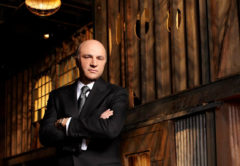By Lara Akl, Communications & Marketing Manager at House of Lebanon
Arabic Calligraphy: Connecting with Culture and Language Artistically
Participants came from as far as San Diego, Irvine, and Riverside to House of Lebanon in Los Angeles on Saturday, October 25, 2014 for a common purpose: To take an Arabic Calligraphy workshop presented by Dr. Imad Bayoun. The class was full and the energy was high. Participants were very excited to learn and to be introduced to this valuable form of art.
Arabic Calligraphy is the artistic practice of handwriting and lettering using special pens or brush and ink. The culture of early Arabs was very creative in terms of poetry and writing. “Early Arabs acknowledged the power and beauty of words. Poetry, for example, was an essential part of daily life. This immense appreciation for the spoken word, later led to an additional appreciation of its written form,” explained Dr. Bayoun.
 The Islamic culture highly values calligraphy as a form of art. The earliest Islamic calligraphy is found in the beautiful copies of the Qur’an. Today, Arabic Calligraphy is a continuously evolving art form. This form of art is just as appealing to young and old artists from diverse cultural and religious backgrounds. They have come to adopt this script as a base for communicating the word and use this stylized script as abstract graphic elements to complement their art.
The Islamic culture highly values calligraphy as a form of art. The earliest Islamic calligraphy is found in the beautiful copies of the Qur’an. Today, Arabic Calligraphy is a continuously evolving art form. This form of art is just as appealing to young and old artists from diverse cultural and religious backgrounds. They have come to adopt this script as a base for communicating the word and use this stylized script as abstract graphic elements to complement their art.
 You do not have to be an artist to practice calligraphy. “Like any other form of art, Arabic Calligraphy nurtures the soul and beautifies life,” said Dr. Bayoun. This charming and appealing form of art attracts community members, Students, and people from different cultural background who seek calligraphy classes and workshops to immerse themselves in a new experience.
You do not have to be an artist to practice calligraphy. “Like any other form of art, Arabic Calligraphy nurtures the soul and beautifies life,” said Dr. Bayoun. This charming and appealing form of art attracts community members, Students, and people from different cultural background who seek calligraphy classes and workshops to immerse themselves in a new experience.
 Our participants’ testimonies varied. “I love calligraphy. I never took calligraphy before and I wanted to give it a try,” said Caren Kouri, one of our participants. Nouha Sinno is one of House of Lebanon accomplished calligraphy artists. She never learned the different theories and scripts of calligraphy. “I practice my own form of calligraphy. I do not follow certain rules and I work more freely. Today, I came to be introduced to the technical way of practicing calligraphy which is based on existing established scripts.”
Our participants’ testimonies varied. “I love calligraphy. I never took calligraphy before and I wanted to give it a try,” said Caren Kouri, one of our participants. Nouha Sinno is one of House of Lebanon accomplished calligraphy artists. She never learned the different theories and scripts of calligraphy. “I practice my own form of calligraphy. I do not follow certain rules and I work more freely. Today, I came to be introduced to the technical way of practicing calligraphy which is based on existing established scripts.”
An additional factor that makes calligraphy a sought after art form is its meditative quality. Its practice requires patience, focus, and concentration. It helps those who practice it transcend their surrounding and context and take them into a very peaceful state of mind. “I forgot about everything around me when I was practicing how to write the Arabic letters. I forgot about my problems. It felt like I am in a different world,” expressed another participant.
Thanks to House of Lebanon Artist Reem Hammad who worked on coordinating the workshop. “Arabic Calligraphy is part of our Lebanese and Arabic cultures,” said Reem. “Offering this workshop falls within House of Lebanon’s mission. Arabic calligraphy is the first point of interest that connects the west with Middle Eastern cultures.”
“Mezze” Table: A Story about Lebanon’s Culture
“Fatoush”, “tabouleh”, grape leaves, “baba ghanouj”, spinach and cheese “fatayer” (pies) were some of the recipes presented by Chef Najwa Massoud during the Lebanese Cooking Workshop House of Lebanon offered on Saturday, November 8, 2014.
“Mezze table” (appetizers) was the theme of the cooking workshop. “Lebanese food is not only healthy, tasty, and has become famous around the world, but it is a great cultural activity to introduce the community to Lebanon’s culture, heritage, and traditions,” said Artist Reem Hammad. “For this reason we reached out to Lebanese Chef Najwa Massoud who offered our participants a taste of Lebanon with every recipe she prepared.”
Food is an essential part of Lebanon’s culture. It reflects generosity and hospitality, two essential characteristics of the Lebanese culture. “Lebanese Mezze” is usually prepared to host special guests, when family and friends get together on Sundays to enjoy their day off, or to celebrate special occasions. “I grew up enjoying family and social gatherings in Lebanon,” said Chef Najwa Massoud.
“I learned that food is an important element of our culture. I acquired most of the recipes from my mother and grandmother. Our house in Lebanon used to get full of people on special occasions and, at an early age, I used to participate and help my mother prepare food. Today, cooking Lebanese food is a passion of mine. As a chef, I witness firsthand the popularity of Lebanese food and how people from different cultural background seek Lebanese restaurants to enjoy our delicious and healthy food.”
Testimonials about the cooking workshop differed. For our Lebanese Americans participants, the cooking workshop brought back memories. “I thought of my “sitto” (grandmother) as I sat there and watched Chef Najwa cook,” said Jeanice Deeb. For other participants, it was fascinating for them to see how the delicious Lebanese dishes they love are prepared. “I love Lebanese food and I go to Lebanese restaurants all the time. It was great to see how grape leaves and spinach “fatayer” are actually made.” Also, the warm and friendly atmosphere during the workshop was very appealing. “It is the cozy and family-like environment that made the workshop more pleasant and enjoyable,” expressed another.
Just like it usually does, our “mezze table” generously brought our participants together at the end of the cooking workshop. They ate the delicious food, exchanged happy conversations, and shouted out thankful messages for Chef Najwa for preparing such a delicious feast!
Ceramic Tiles: Exploring History of Islamic Art
Carefully handling the clay, imprinting a pattern of choice on its surface, carving and shaping, participants looked forward to a beautifully decorated piece of ceramic tile they worked on at the Handmade Ceramic Tiles workshop offered by House of Lebanon on Saturday, November 8, 2014.
Exploring Islamic Patterns was the theme. Reem Hammad is the artist who conducted the workshop. She guided participants through the different stages of working with and decorating ceramic tiles by choosing from a variety of classic Islamic design patterns.
The intricate artistic designs, decorations, and geometric shapes used on tiles and carved architectural details in Islamic civilizations, have not only been an important field of modern academic research like mathematics, art, and architecture, but it has inspired artists from around the world. Arabesque and geometric designs have been at the center of Islamic Art and have been recreated and adapted throughout the years until this day. “I have always been fascinated with Islamic patterns and have adopted them in my ceramic tile designs to be used as Mandalas or meditation focal points, or simply as decorative tiles,” said Reem Hammad.
Interested in the art of ceramic tiles, participants came to the workshop with no background experience. “I love ceramics. I always wanted to do it and it wasn’t possible when my kids were younger. Today I came to learn about it and enjoy a relaxing form of art,” said one of the participants.
Christian Nahas, a calligrapher and a graphic designer who took the workshop. He was interested in learning “another method to apply calligraphy,” said Christian. He has only used paper for calligraphy, “but now I can apply it on clay and it’s exciting.” Nouha Sinno, a painter, said that this was her first time she works with ceramic tiles. “I do it for the experience. It adds more knowledge to my existing skills.”
Ceramic tiles have a long history in the Middle East. From Iran to Turkey, Egypt to Morocco, this art form went off to spread into European countries, like Spain and Italy. Ceramic tile design continued to flourish and develop borrowing old techniques of lusterware and Majolica. They were used throughout the region to decorate mosques, churches, and palaces. Ceramic tiles’ hardened and glazed surfaces offered a durable and weather proof decorative elements used as accents and ornamentation for exterior spaces. This captivating form of art can be seen in many great architectural landmarks like Isfahan Mosques in Iran, Topkapi palace in Turkey, the Alhambra Palaces in Spain to name a few.
Introducing this form of art to the community was a rich cultural and educational experience for our participants.
Get Involved: Join House of Lebanon
House of Lebanon is the nation’s first urban Los Angeles-based Lebanese-American cultural and educational center.
House of Lebanon is owned by the Lebanese American Foundation, which is a non-profit, non-political, and philanthropic organization founded more than twenty years ago to serve the Lebanese-American community throughout Southern California and abroad with one goal: to build a “House of Lebanon” – a cultural and educational center in Los Angeles.
To learn more information, visit houseoflebanon.com, or join them on Facebook.





























